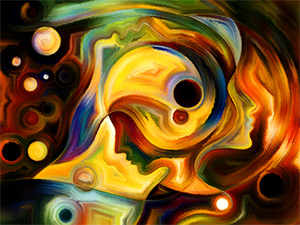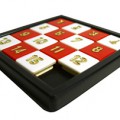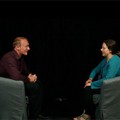
Not everything you do in therapy will appear logical to the outside observer
“To see a World in a Grain of Sand
And a Heaven in a Wild Flower
Hold Infinity in the palm of your hand
And Eternity in an hour”
—William Blake
Therapy is as much an art as a science. But where does the artistry come from?
It comes only when we have honed our therapeutic and interpersonal skills and knowledge – through experience, not just theory – to the point where the unconscious mind is free to work intuitively.
The plodding, analytical mind has its place in therapy, of course, but in my opinion that part of the mind is just one tool. A part of what it means to be human. It needn’t run the whole show.
But how far might therapeutic intuition extend?
That’s what I want to explore in this article. It’s a little different from the ‘how to’ blogs I am in the habit of producing. In this piece I am being explorative. Just putting it out there.
I am not dogmatically arguing the existence of therapeutic clairvoyance. As I hope you know, I am a stickler for common sense in psychology and therapeutic practice. But it is sensible to be open minded to what might sometimes be possible. Just as we shouldn’t place limits on our clients, nor should we limit ourselves as therapists.
So with that – rather defensive – caveat, I’m going to tell you a weird story. And I’d love to know if you have had a similar experience.
Here goes!
“I should have known a man who could read my mind could help me.”
June worked in the law courts as an administrator and constantly worried, to an obsessive-compulsive degree. She’d worry frantically about whether she had really given this or that piece of paper to this or that lawyer – and not just at work; it was starting to affect her home life as well. Her career demanded that she be careful, but her natural thoroughness had tipped into exhausting obsession.
I did lots with her in our first session, and I adhered to many of the principles of good practice for OCD treatment. But although I considered her needs logically, I also consciously opened myself up to allowing a pattern to present itself. Then a strange thing started to happen.
Why am I saying this?
We had not discussed June’s reading habits, yet I kept finding myself mentioning – of all things – the character of Heathcliff from Charlotte Bronte’s Wuthering Heights. This was certainly not something I planned. Actually, I’ve never even read the book! (Although I do have a vague idea of the plot and characters.)
As June moved in and out of trance I alluded to the moors on which Wuthering Heights is set and even to the haunting Kate Bush song about the death-defying love between Cathy and Heathcliff. It somehow made sense to me at the time in relation to her OCD.
I did a lot of other stuff with her too, but Wuthering Heights somehow ended up being the central thread that weaved it all together. I didn’t know why I was using analogies from this book. I’d never mentioned it with a client before, and I’ve never mentioned it since.
June left looking relaxed and seemed happy with the session, but I assumed I would need to see her several times for what was quite a bad case of OCD.
I was in for a surprise.
Good news
The following Friday I got a call.
“Mark! Good news. I’m so much better. I’m still thorough, but now I only check normally, and once I’ve dealt with one issue at work then I’m onto the next one and I’m not worrying all the time. Thank you so much.”
I stifled my surprise and let her give me the credit for possibly the most dramatic cure of OCD I’d ever seen! But nothing could have prepared me for what she said next.
“Mind you… I should have known that a man who could read my mind – who could know without me telling him that my favourite book is Wuthering Heights, a book I’ve read a dozen times – would be able to help me!”
Switching from transmit to receive
Now I’m not saying I did read her mind and somehow picked up on and used her overriding interest in Heathcliff without it having passed between us verbally. Though I do remember thinking how open and spontaneous I felt during that session. But forget mind reading for a moment.
Maybe mind reading, mind merging, or whatever you want to call it sits on the far end of a continuum of human knowing, or maybe it doesn’t. Maybe I’d subliminally picked up something about Wuthering Heights from TV the day before without realising it, or maybe I hadn’t.
But on some level, most of us accept the concept of intuition; that is, knowing through unconscious means, before or outside of conscious awareness. And for normal intuition to work in the context of a therapist-client relationship, we need to not only have the right skills, but also be able to enter the right state of consciousness. Let’s explore that concept a bit further.
Mindful listening
Really listening enables us to pick up metacommunications from other people. Metacommunications are nonverbal means of communication. The way we emphasize certain words, the way we look when they speak, the patterns of our communication… not what we say, but how we say it.
When you first became a therapist, you may have found yourself burying your head in your notes or constantly thinking about what you were doing, rather than what your client was doing. I’ve known some therapists that never quite got out of this pattern. But when we practise therapy in this way, we risk listening only with our ears.
It’s not as crazy as it sounds.
Listen with your eyes
The great psychological healer Dr Milton Erickson was a man who could really listen. Intriguingly, his daughter Betty described him as a man who would “listen with his eyes.” She was spot on. To really listen, we need to really look. And to do that, we need to go from ‘transmit’ to ‘receive’.
But this means more than simply closing our mouths. It’s easy to nod and chime out the cliché “I hear what you are saying”, but if internally I am thinking about what I am doing or going to do, it’s still about me.
Even though superficially I seem to be on receive – because I’m not actually talking – for all practical purposes I am not being receptive to the client in the context of the therapy session.
So if it’s that easy to be on ‘transmit’ even when we are silent, how do we learn to really listen?
Altered states
“But as the child fears the dark… the adult child will be fearful too, faced with the dark world of the unknown mind, with vast concepts looking enormous just beyond the front yard.”
—Dr Arthur J Deikman
If you can learn to feel relaxed and truly confident when you treat a client, you will naturally become more reliably intuitive in your interventions.
It’s all about understanding, and learning to control, our consciousness. By adopting a calm and meditative state during a therapy session, you can let your sense of self fade away and instead allow your consciousness to merge with that of your client. And the deeper you go into the session, the easier this will become.
The psychiatrist and writer on psychiatry and mysticism Dr Arthur J Deikman talked about two modes of consciousness – the actionmode, and the receptive mode. We all have these modes, and we all use them. But few of us understand them – and it may just be the key to unlocking new experiences and treatments for our clients.
Action mode
In action mode, we act upon the environment. We try. It’s all about us as separate from the world and other people around us. It’s about doing, getting, manipulating… whatever it takes to get our needs met (even when those needs involve helping someone else).
Action mode has evolved for biological survival. It’s the part of us that objectifies the world and separates one thing from another. It’s about me as separate from you, life, and the world. It’s the basis of survival, but it can also be the basis of fears, weaknesses, and vices.
And it’s the part of us that laments getting old and the prospect of dying, because its primary role is that of acquisition, of furthering our own agenda, with little consideration of how we fit into the greater scheme of things.
Action mode is an important part of therapy, as it can help us strategize (What do I do next? What intervention does this client need?). But on occasion, it’s appropriate to still this mode so that more subtle, but perhaps more powerful, modes of being and perception can emerge.
There’s no doubt that action mode is vital, and it’s only logical that it is the mode most of us are in, most of the time. The problem arises when it’s the only mode we know.
Understand that there is a second mode, and learn how to use it. If you don’t, you are effectively condemning yourself to restricted consciousness and relative ineffectiveness.
Compare this to Deikman’s second mode of consciousness.
Receptive ‘intuitive’ mode
Receptive mode is more merged with the people and things around us. The boundaries between ourselves and our surroundings are less compartmentalized, and constructions of the action mode, such as self-consciousness, fear, and anxiety, disappear. Most of us experience this mode at least occasionally. It’s akin to being ‘in the zone’ or ‘in flow’, and it typically needs to be allowed rather than forced to emerge.
In receptive mode we merge with what we are focusing on, and we, as a separate entity, effectively disappear from our own consciousness. Trance, meditation, hypnosis, and reported mystical experiences all occur in receptive mode.
But the most intriguing thing about this mode is that it seems to give us access to forms of knowledge not normally available. It’s in receptive mode that people report ESP, clairvoyance, and other super-sensory phenomena.
This is nothing to do with sentimentality or emotionality. In fact, we are most receptive when our consciousness is unclouded by either analysis or excessive feeling. Calm is the medium, it seems, for intuitive ‘super knowing’.
Beyond thinking and feeling
In his book Meditations on a Blue Vase, Deikman suggests that for many people the idea that there is a way of knowing outside of thought or imagination may be unfamiliar. We base what we ‘know’ on two basic domains: logic and emotion. But maybe there’s room for a third domain – that is, intuition.
Clearly, the therapist needs to find a balance between the modes of consciousness. Too much action mode and the therapist is all cold logic, strategy, and note taking; too much receptive mode and the client may find the approach too woolly, passive, and unstrategic to be of use.
I’ve said already that therapy is as much an art as a science, and I firmly believe that the best therapists have mastered both aspects. But like anything, it takes time.
I think the first step to developing reliable therapeutic intuition (assuming that’s possible) is to develop profound confidence in your therapeutic knowledge. Don’t let lack of self-confidence shore up action mode at the expense of a powerful receptive perception.
As I said in the introduction to this article, this is all about exploration of different perspectives and modes of consciousness, and I’d love to hear your thoughts on everything we’ve discussed.
I had the pleasure of being in the audience thirty years ago when Arthur Deikman spoke in London. I’ll leave you with his words:
“At its most basic, the spiritual is the experience of the connectedness that underlies reality. The depth of that experience depends on the capacity of the individual to set aside considerations of self, thereby gaining access to connection.”










